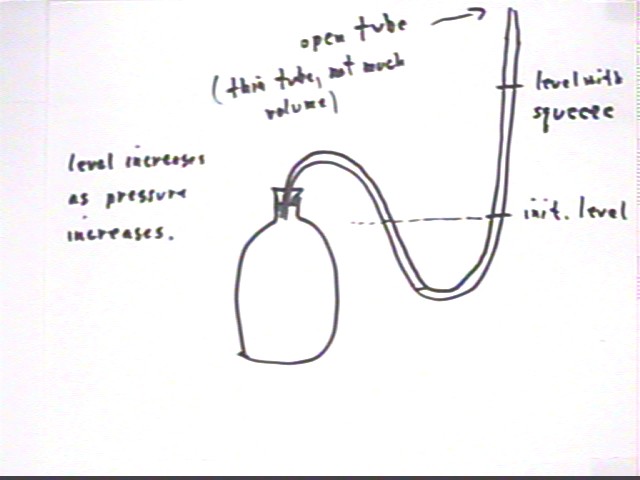
indexed
The situations observed during the preceding class are summarized below, with the figure representing a column of alcohol in a thin U tube (inner diameter 1/8 inch) partially filled with alcohol and extending from a sealed 3-liter bottle, represented by the figure below.

The fluid in the tube initially had equal pressures in the 'bottle side' (point B) and the 'open side' (the vertical part of the tube, which includes point A). The initial fluid level was the same in both sides of the tube; this initial level is not represented in the figure.
When the bottle was squeezed a bit we found that the fluid was displaced in the counterclockwise direction so that the level in the vertical part of the tube, open to the atmosphere, is greater than that in the 'bottle side' of the tube.
We wish to compare the pressure at A with that at B. Call these pressures PA and PB.
This conclusion is consistent with our intuition that by squeezing the bottle we increased the pressure of the air inside the bottle. Note that the pressure at point B, where the air in the bottle meets the fluid in the tube, is the same for the air as for the fluid.
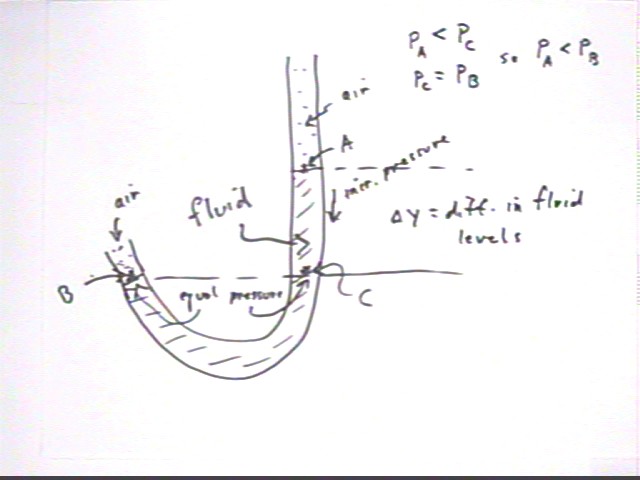
The situation can be analyzed from the point of view of Newton's Second Law. Since the fluid is stationary we conclude that the net force on the fluid is zero. There is a force F1 exerted on the fluid at point B, tending to accelerate the system in the counterclockwise (positive) direction, and a force F2 at point A which tends to accelerate the system in the clockwise (negative) direction.
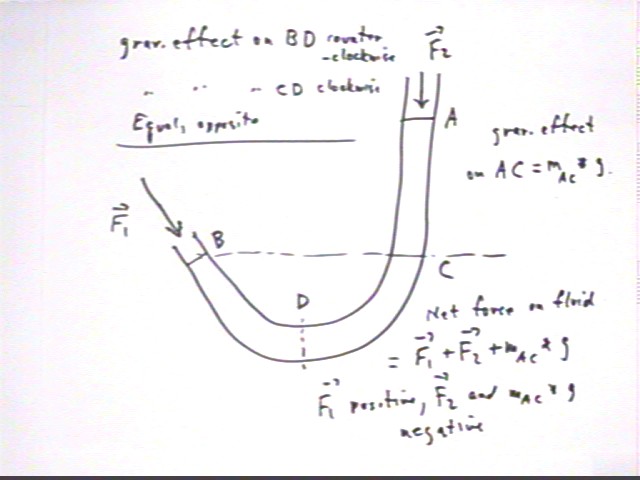
In the situation depicted below the vertical tube is closed at point A. We consider what we observed when the bottle was squeezed with the tube closed, compared to when the tube was open. A much harder squeeze than before resulted in only a small change in the position of the fluid.
Noting that the difference in level B and level C ' is small compared to the difference observed with the open tube, and that the squeeze necessary to create the large difference in the open tube was much less than the squeeze used to get the small difference with the closed tube, we conclude that the pressure difference between level C ' and level B is much smaller than the pressure difference due to the compression of the air in segment AC.
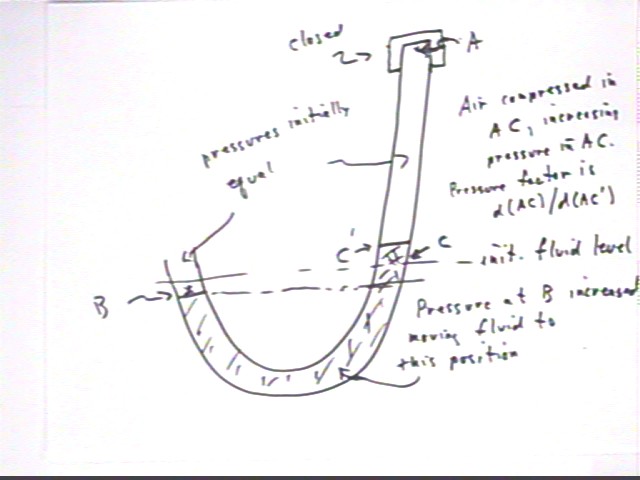
The situation depicted below will demonstrate how the pressure in a stationary fluid depends only on the density of the fluid, the depth and the gravitational acceleration.
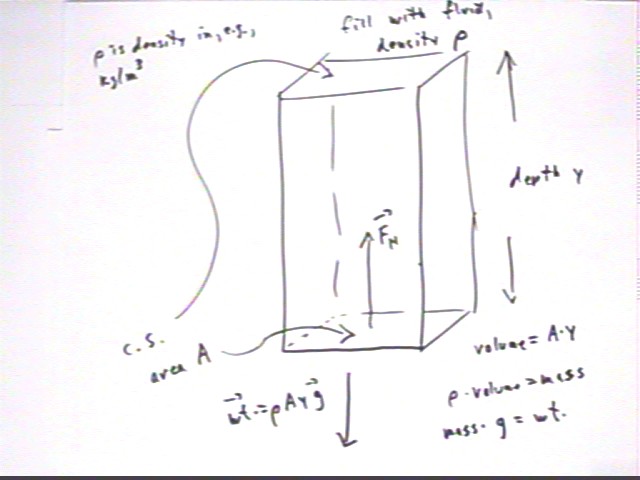
The force Fnormal is therefore
This force is equally distributed over the base of the container, so it makes sense to speak of the force per unit area.
This force per unit area is the pressure. A simple calculation shows us that at depth y the pressure is
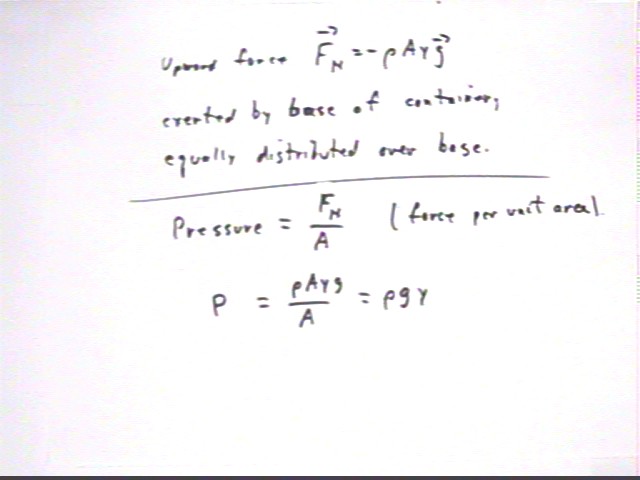
We now consider a container filled to depth y, relative to a hole from which fluid can exit.
The demonstration is class showed such a system (a plastic bottle with a hole poked in the side). As water exited the hole and decreased the depth of the water, the velocity of the exiting water decreased, thereby decreasing the rate at which water exits the container. The result is a decrease in the rate at which the depth decreases.
The pressure of the water is the source of the force which accelerates water out through the hole.
If the water flows thru a short tube on its way out of the container, assuming that the only forces exerted are by the pressure, then we see that the water in the tube experiences force F_c = (rho g y + P_atm) * A to the right and force F_b = P_atm * A to the left. (This model simplifies the situation and ignores frictional forces, e.g. between water and tube walls, as well as the presumably small relative velocity of the water just inside the container next to the tube.)
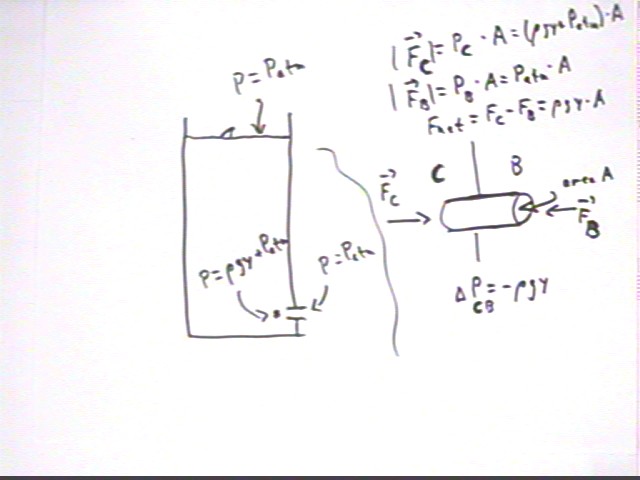
Thus we know the net force on the water in the tube. If we know the mass of the water we can therefore find its acceleration.
mass = rho * A * L.
a = Fnet / m = rho g y * A / (rho * A * L) = g y / L.
We now have enough information to find the velocity of the exiting water. We have assumed that before entering the tube the velocity of the water was zero. Tts acceleration is g y / L and the accelerating force acts through displacement `ds = L.
v_Exit = sqrt ( v0^2 + 2 a `ds ) = sqrt ( 0 + 2 * (g y / L) * L ) = sqrt( 2 g y).
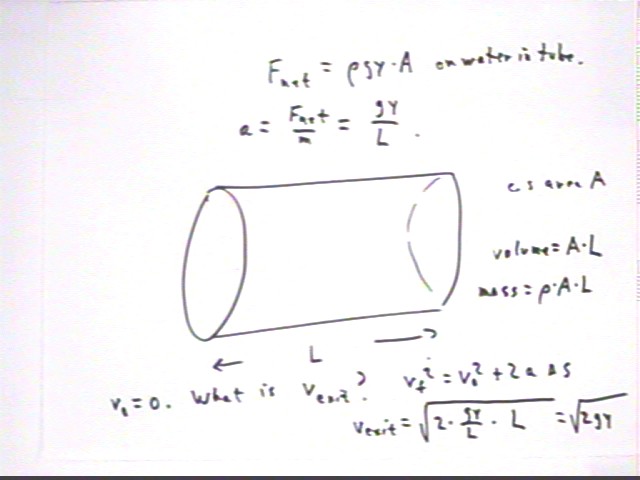
We also observed that when the system is in free fall (having been dropped or tossed upward) there is no flow from the opening. This is because the pressure in the fluid is a result of the normal force needed to hold the fluid stationary against gravitational forces. If the system is in free fall its acceleration is equal to that of gravity, so that the net force on the fluid is equal to its weight, and no normal force is required. The result is zero pressure, so there is no force to accelerate the fluid out of the hole, and the flow ceases.